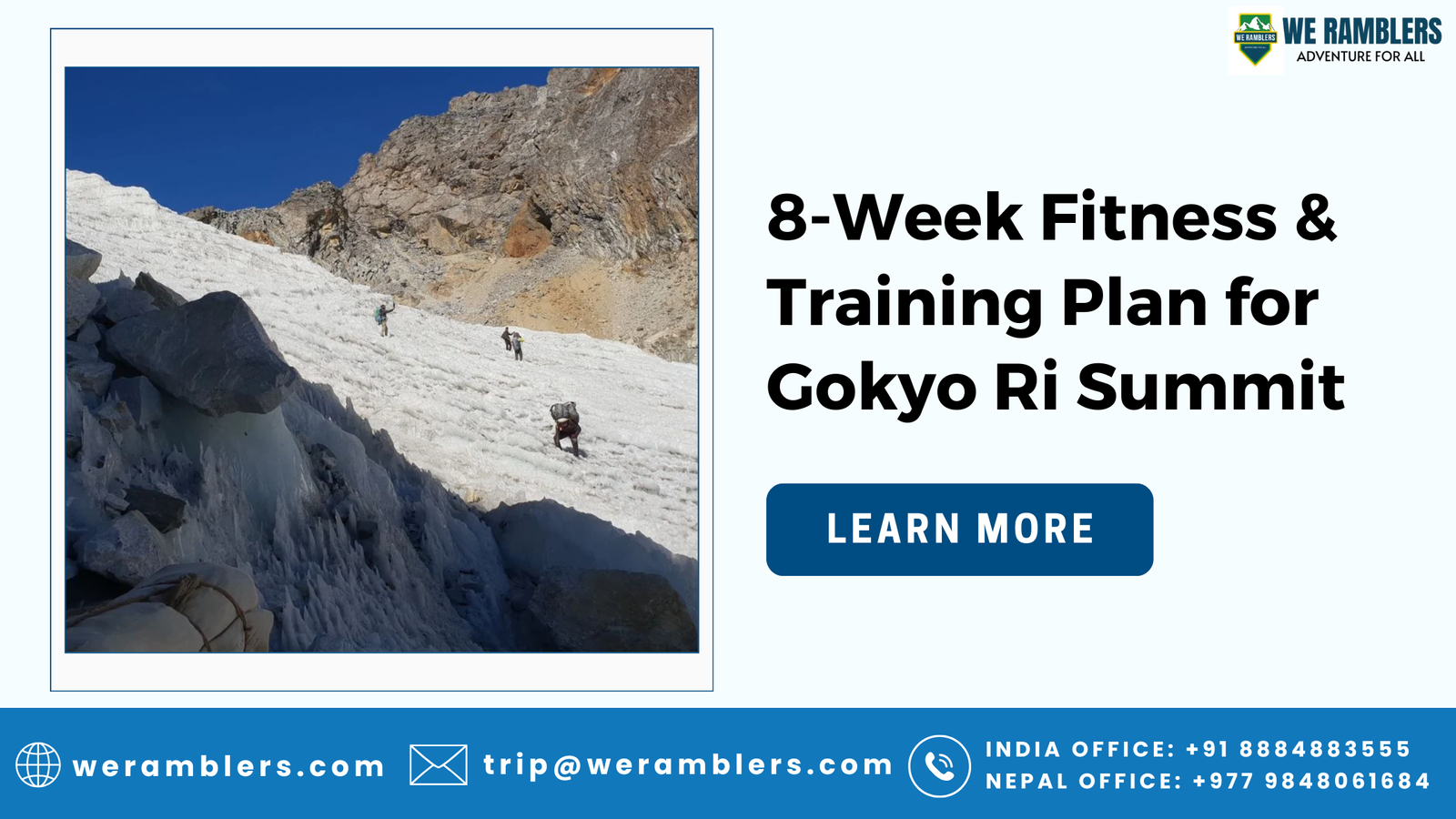Fitness & Training Plan for Gokyo Ri Summit (8-week Plan + Exercises)
The Gokyo Ri Summit in Nepal’s Everest region is one of the most rewarding treks in the Himalayas. Standing at an altitude of 5,357 meters (17,575 ft), this trek offers incredible views of Mount Everest, Lhotse, Makalu, and Cho Oyu, some of the world’s highest peaks. But reaching the top requires more than just enthusiasm; it demands preparation, endurance, and physical readiness.
In this detailed guide, we’ll walk you through a complete 8-week Gokyo Ri training plan, tailored for both beginners and seasoned trekkers. Whether your goal is to prepare for Gokyo Ri, build your fitness for high altitude treks, or improve your stamina for long uphill climbs, this article covers it all, step-by-step.
Understanding the Challenge: Why You Need a Gokyo Ri Training Plan
The Gokyo Ri trek is moderately difficult, involving 10–12 days of trekking at elevations above 3,500 meters. The final climb from Gokyo Village (4,790 m) to the summit of Gokyo Ri (5,357 m) is steep, rocky, and demands endurance, leg strength, and mental determination.
Even if you have some trekking experience, training your body beforehand with a structured Gokyo Ri training plan is crucial. It prepares your muscles, lungs, and heart for the demands of high altitude, where oxygen levels drop to 50–60% of normal.
Key Gokyo Ri Trek Facts:
- Trek Region: Everest (Khumbu) Valley, Nepal
- Highest Point: Gokyo Ri – 5,357 m
- Total Duration: 10–12 days
- Difficulty: Moderate to Challenging
- Highlights: Gokyo Lakes, Ngozumpa Glacier, and panoramic Everest views
Why Fitness Training is Essential for Gokyo Ri
Trekking at high altitude is different from regular hiking. Lower oxygen levels affect breathing, endurance, and muscle performance. A focused Gokyo Ri training plan will help you:
- Increase cardiovascular endurance for long climbs
- Build muscle strength (especially in legs and core)
- Improve balance and stability on uneven terrain
- Enhance lung capacity for high altitude conditions
- Reduce the risk of AMS (Acute Mountain Sickness)
Your goal isn’t to train like an athlete; it’s to build sustainable stamina and strength to trek for 5–8 hours a day comfortably.
8-Week Gokyo Ri Training Plan
Below is a simple but effective 8-week training plan to get trek-ready. It’s divided into two phases: Foundation and Summit Preparation. You can do this from home or at your local gym.
Weeks 1–4: Building the Foundation
Objective: Develop endurance, cardiovascular strength, and a fitness base.
1. Cardio (4–5 days/week)
Focus on steady aerobic workouts — walking, jogging, cycling, or swimming for 45–60 minutes. If possible, include uphill walking or treadmill incline training to mimic mountain conditions.
2. Strength Training (3 days/week)
Target key trekking muscles — legs, glutes, and core.
Exercises to include:
- Squats – 3 sets of 15 reps
- Lunges – 3 sets of 12 reps per leg
- Step-ups (using stairs or a bench) – 3 sets of 10
- Plank – 3 x 30 seconds
- Side Plank – 2 x 20 seconds
3. Flexibility & Mobility (Daily)
End each workout with 10 minutes of stretching – hamstrings, calves, hips, and shoulders. Yoga poses like Downward Dog, Warrior Pose, and Child’s Pose are excellent for flexibility.
4. Weekend Hikes
Start hiking on weekends carrying a light backpack (4–6 kg). This helps your body adapt to walking long distances on uneven terrain.
Weeks 5–8: Elevation & Endurance Training
Objective: Prepare your body for altitude and simulate trekking conditions.
1. Cardio (5–6 days/week)
Increase intensity with hill runs, stair climbing, or interval training. Aim for 60–75 minutes per session.
Example: 10 min warm-up → 5×(5 min uphill run + 3 min walk) → 10 min cooldown.
2. Strength & Endurance (4 days/week)
Enhance leg power and stability with added resistance or weights.
- Weighted Squats – 3 sets of 10
- Walking Lunges – 3 sets of 10 per leg
- Deadlifts – 3 sets of 8
- Step-ups with backpack – 3 sets of 15
- Mountain Climbers – 3 x 20 reps
3. Trek Simulation
Go for long weekend hikes (6–8 hours) carrying a 8–10 kg backpack. If you live near hills, practice climbing up and down for 2–3 hours.
4. Breathing Practice
Practice diaphragmatic breathing and nasal breathing during workouts to improve oxygen efficiency, a key factor for fitness for high altitude trek.
Strength, Flexibility & Mental Conditioning
Physical strength alone isn’t enough for Gokyo Ri; flexibility and mental resilience matter too.
Yoga & Core Training
Add 2–3 yoga sessions weekly focusing on balance, flexibility, and controlled breathing. Core stability exercises like planks, leg raises, and Russian twists will help you maintain posture and reduce lower back strain during long ascents.
Mental Preparation
Mental endurance is what pushes you when your body tires. Visualize your trek, practice mindfulness, and take shorter but consistent steps. This positive mindset will be your greatest asset on summit day.
Nutrition Tips During Training
Fueling your body with proper nutrition is essential when following a Gokyo Ri training plan.
- Carbohydrates: Whole grains, fruits, and oats for sustained energy.
- Protein: Eggs, lentils, lean meats, and tofu to rebuild muscles.
- Healthy fats: Nuts, seeds, and avocados for energy support.
- Hydration: Aim for 3–4 liters of water daily. Dehydration worsens altitude symptoms.
Before your trek, gradually reduce processed foods and alcohol intake to improve stamina and oxygen efficiency.
Altitude Acclimatization: Prepare for Gokyo Ri
As you train for Gokyo Ri, remember that acclimatization is as much about pacing as fitness. Here’s how to stay safe at high altitude:
- Ascend slowly and allow your body to adjust.
- Drink plenty of water.
- Take acclimatization rest days (typically at Namche Bazaar and Gokyo Village).
- Avoid alcohol and smoking.
- Listen to your body; headaches, nausea, or shortness of breath are early signs of altitude sickness.
Practicing controlled breathing and maintaining steady hydration levels during your Gokyo Ri training plan helps prepare your lungs for the thinner air up high.
Additional Training Tips for Gokyo Ri Trek
- Use a weighted backpack during cardio sessions to simulate trekking load.
- Focus on core balance to improve stability on rocky terrain.
- Get adequate sleep and recovery. Muscles grow stronger during rest.
- If possible, do short treks or hikes before Gokyo Ri to test your fitness level.
Final Thoughts: Conquer Gokyo Ri with Confidence
The Gokyo Ri trek is a physically demanding but immensely rewarding Himalayan adventure. Following an 8-week Gokyo Ri training plan tailored for endurance, strength, and altitude preparation ensures you’ll enjoy every moment of your journey, from the turquoise Gokyo Lakes to the panoramic summit view of Everest.
Remember, training consistently and listening to your body are key. When you reach the top of Gokyo Ri and see the world’s highest peaks around you, every drop of sweat and every training session will feel worth it.
Ready to Trek Beyond Ordinary? Join We Ramblers Today
Your Himalayan adventure deserves more than just a plan; it deserves a team that knows the mountains by heart. At We Ramblers, we don’t just organize treks; we craft unforgettable journeys led by certified local experts who live and breathe the Himalayas.
Whether you’re conquering the Gokyo Ri Summit, exploring the serene Mardi Himal trails, or taking on the legendary Everest Base Camp, our experienced guides ensure safety, comfort, and true adventure every step of the way.
- Professionally managed & fully serviced treks
- Small-group departures with personalized attention
- Safety-first approach & experienced local guides
- Hassle-free logistics, from permits to accommodations
So, pack your determination, follow your calling, and let the We Ramblers team turn your dream trek into reality.
Frequently Asked Questions (FAQs) on Gokyo Ri Training Plan
1. How long should I train before trekking Gokyo Ri?
You should follow an 8–10 week Gokyo Ri training plan to build endurance, leg strength, and cardiovascular fitness. The longer you train, the more comfortable your trek will be.
2. Is Gokyo Ri trek suitable for beginners?
Yes, it’s ideal for fit beginners who follow proper preparation. If you train for Gokyo Ri consistently with hikes and cardio, you can complete it safely and confidently.
3. What exercises help most for Gokyo Ri?
Focus on squats, lunges, stair climbs, planks, and uphill hikes with a backpack. These exercises build fitness for high altitude trek and prepare you for steep ascents.
4. How do I prepare for altitude on the Gokyo Ri trek?
Hydrate well, ascend gradually, and add breathing exercises during your training. Include hiking at local hills or stairs to simulate uphill climbs and improve lung capacity.
5. How fit do I need to be for Gokyo Ri Summit?
You should be able to trek 6–8 hours a day carrying a 10 kg pack without exhaustion. Following a structured Gokyo Ri training plan will help you reach that level safely.
Book your next Himalayan trek today at We Ramblers and start your journey to the roof of the world!





